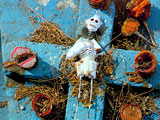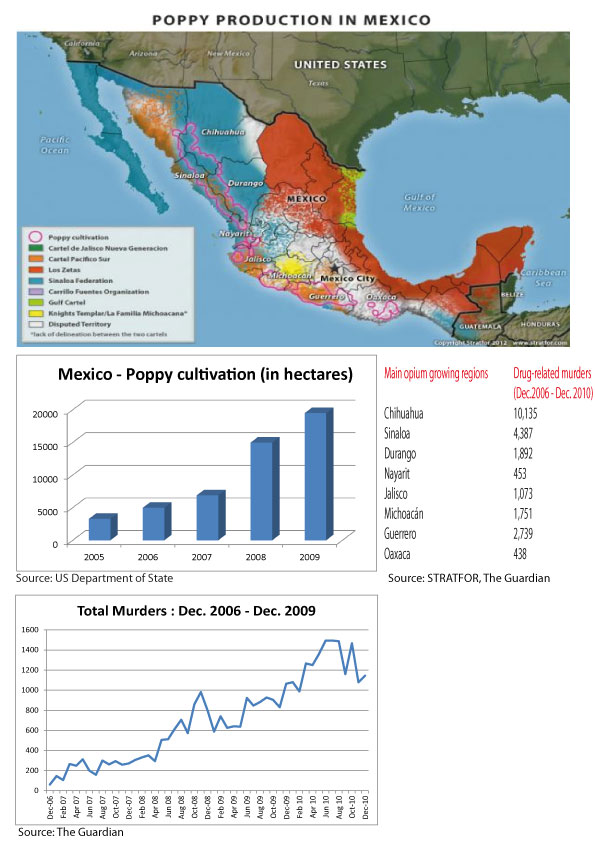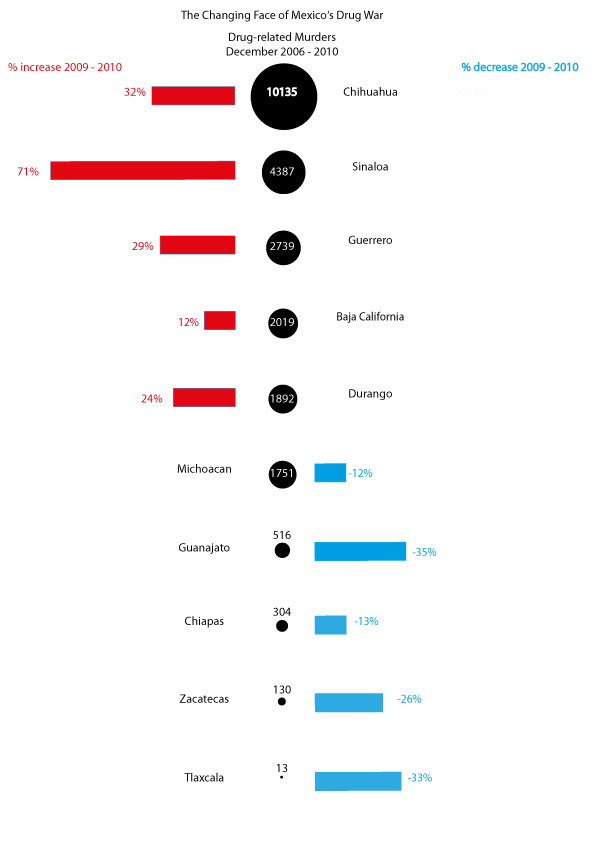A Lethal Cocktail: Drugs, Guns and Corruption
25 Apr 2012
As noted yesterday, localist, separatist and indigenous movements pose a challenge to greater regional integration in North America. These movements, however, are not the only obstructions. In Mexico and Central America, violence associated with the production and transportation of illicit drugs for northern markets remains a powerful source of socio-political dislocation and entropy, and therefore an impediment to greater political integration. This problem, however, may not be as all-consuming as it first appears. As the graphics below indicate, Mexican cartels are indeed more influential in some parts of the country than the government itself, with murder rates closely tracking the intensity of drug cultivation in these areas. And yet, although drug-related murders have been rising in states such as Chihuaha, Sinaloa and Guerrero – where drug-related violence has traditionally been high – there exists a counter trend. Violence is on the decline in states such as Michoacan, Guanajato, and Chiapas, where it traditionally has been less intense. This trend suggests that while drug violence in Mexico may be intensifying, it also remains concentrated within certain historically troubled areas of the country. Mexico, in other words, may be portrayed in some quarters as a narco-state, or even as inching its way towards state failure, but a democratically elected government still functions there – a state that could, in due time, help intensify the regional political ties that bind. Such hopeful, forward-looking first steps already exist, including the external pageNAFTA-Plus proposals spearheaded by former Mexican President Vicente Foxcall_made, and the external pageSecurity and Prosperity Partnership of North Americacall_made initiative, which began in 2005. Thus far these efforts remain largely ‘empty vessels’, but the templates are in place. To populate them properly, however, will require the remediation of two huge problems – official corruption and government complicity in a drug trade that destabilizes much of the region.
Mexico
According to data provided by the US State Department and the Guardian, poppy cultivation in Mexico rose in tandem with murder rates between 2005 and 2010.
Mexican states with the highest numbers of drug-related murders between 2006 and 2010 also experienced large percentage increases in those murders for the year 2009-2010. Conversely, the states with the lowest numbers of murders over that five-year period experienced large percentage declines in the final year. Different conclusions might be drawn from these data, but analysts have concluded that drug-related violence in Mexico is becoming both more intense and more geographically specific. That’s a good news story for a central government seeking to maintain its sovereignty and even enhance it with greater ties with other states.
Central America
As in the case of Mexico, drug-related violence is a serious source of political entropy across Central America, where fragile states serve as conduits for drugs originating in Colombia and other parts of South America. As the above graphic illustrates, drugs reach Mexico and the United States via these countries by land, sea, and even (in the cases of Honduras and Guatemala) by air. The deleterious effects from such trafficking, particularly at the government level, include a loss of legitimacy with domestic populations and a loss of credibility abroad. In turn, the negative effects it has had on regional cooperation include undermining the effectiveness of integration initiatives (such as the external pageCentral American Integration Systemcall_made), as well as decreasing the prospects for a regional currency union. Indeed, economic integration external pagewill remain unlikelycall_made as long as drug violence continues to scare foreign investment away from Central America and to prevent significant levels of intra-regional trade from developing.
Complicit Governments?
A major assumption associated with the above statistics is that the governments under discussion are merely the victims of drug-related violence and instability; those working within them would not be so suicidal as to undermine themselves through corruption, or so it is assumed. But what if the obvious question is not determining whether the region’s governments are victims or not? What if the actual question turns on just how corrupt and complicit large sections of self-immolating governments are in the production and trafficking of illicit drugs? Well, if we are to believe the 2011 Corruption Perceptions Index, all of the governments in the region scored below the half-way mark, with Nicaragua registering a lowly 2.5 out of 10. The reasons for this unhappy state of affairs external pageare legion and includecall_made low individual salaries, the perceived (and actual) ineffectiveness of the rule of law, civil and public institutions that are instrumentalized (and therefore enfeebled) by political elites, and the increasingly widespread perception that governments themselves are complicit in– or ultimately turn a blind eye towards – the violence that does undermine these countries. What this all tells us, unfortunately, is that the consolidation of political power in this part of the world will not ascend to the “next level” until the forces of localism and corrupted governance are either addressed or, worse yet, have run their course.
Recommended Reading
Shirk, David. external page"Drug Violence in Mexico: Data and Analysis from 2001 -2009."call_made Trends in Organized Crime, 2010
Booth, William. external page"Mexico Hobbled by Drug War Arrests that Lead Nowhere."call_made The Washington Post, 2010
Dudley, Steven. external pageShared Responsibility: US-Mexico Options for Confronting Organized Crimecall_made. Woodrow Wilson International Center for Scholars, 2010
Pearce, Jenny. "external pagePerverse State Formation and Securitized Democracy in Latin Americacall_made" Democracy and Violence, 2010
Grandin, Greg. external page"Muscling Latin America."call_made The Nation, 2010
Wolf, Sonja. external page"Mara Salvatrucha: The Most Dangerous Street Gang in the Americas?"call_made Latin American Politics and Society, 2012





